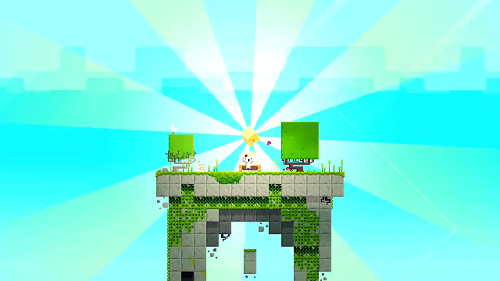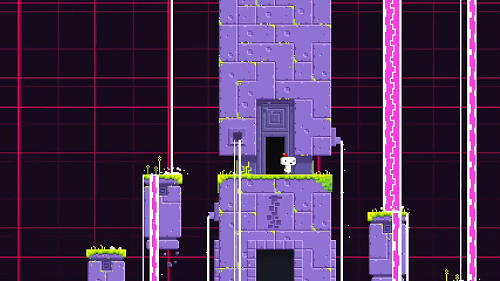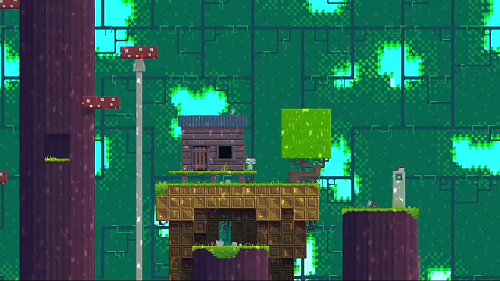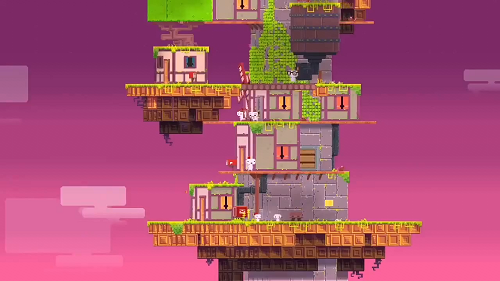By Samantha “Kitten” McComb

Okay, before anyone starts on PHIL FISH, I guess he’s a jerk and he apparently didn’t deserve to enter his game into a contest multiple times or something. Who cares? Ok, cool, now that’s out of the way. Let’s talk about Fez, and not talk about Phil Fish.
You’ve all probably seen the videos and have the general gist of the game: it’s a 2D platformer that is composed almost entirely of voxels, and the big “thing” about the game is that you’re able to rotate your perspective to face any of the outward facing four sides of the very cube-oriented world. Rather than traditional levels, the game is a gigantic, interconnected hub with no enemies and instant respawning upon “death” on the last safe platform you stood on. The game’s emphasis is on exploration, puzzle-solving and collecting items.
One might expect the perspective shifts to be the only interesting thing about the world, but they would be sorely incorrect. Fez has a really wide berth of creative puzzles, most of which I can’t really begin to describe without simultaneously unraveling their conclusions. Something I can say without spoiling anything is that I’ve actually been playing the game while jotting down notes and replicating symbols I see on walls in MS Paint, and I strongly doubt anyone will complete the game without doing this or taking advice from someone else who has done it. Cryptology is just one element of a few of Fez’s many puzzles, however, and it’s very cleverly implemented where it is. Don’t expect to stroll into a room with translations clearly detailed on the walls, you’re going to be made to think.

To speak of the game’s collectibles: There are 32 “cubes” in Fez, which are often collected by obtaining 8 miniature cubes. There are also 32 “anti-cubes” along with a few collectible artifacts (and 3 very well hidden red cubes that presumably reveal the game’s true ending,so far, the internet seems to have collectively only found 2). You need only 32 total cubes to get an ending, which is very easy to do given that the ordinary cubes and cube shards are littered about the game, and you’re likely to discover at least a few anti-cubes without trying too hard. Beating the game this way is still somewhat satisfying (you get a really neat ending sequence), but leaves a lot to be desired.
The real difficulty in Fez lies in collecting the anti-cubes, which can be incredibly hard to get and are sometimes hidden in really, really cool areas that are very easy to miss if you’re not trying to collect everything (not to excessively gush, but I was seriously amazed by two of them, in particular). I’m not a huge puzzle gamer, but I feel like I did fairly well in getting the vast majority of the game’s secrets on my own, and I was immensely satisfied upon solving some of the puzzles. While I did have to resort to looking a few things up, I completed the game with the 64 cube ending with pretty minimal help (just keep in mind that some puzzles can’t be solved until you unlock first-person view by getting the game’s first ending).
While most of the puzzles are genuinely well crafted, there are a few frustrating/ridiculous ones. For example, there’s a clock puzzle with one hand for each of the four perspectives. Reaping the maximum reward for this puzzle requires either messing with your 360’s internal clock and remaining offline, or waiting up to 48 hours. Fortunately, the game leans heavily in favor of clever puzzles over tedious or ridiculous ones, and there aren’t many like this. A lot of people have heavily riffed on the game having QR codes that require a smart phone, but the solutions are present elsewhere in the game if you don’t have one (even still, you can just take a picture of them with a digital camera, upload it to the computer, then use a website to translate).

The game isn’t entirely puzzles and collecting, however. The platforming, while simple enough for newer players and generally pretty easy, remains engaging due to the use of the perspective shifts. This innovative mechanic adds a new layer to the genre that you’ve never really experienced before, which prevents it from becoming stale. There are a lot of neat gimmicks in the game that help accent this feature, too, most of which are a bit too difficult to describe without a visual aid. Combined with the variety of difficult puzzles, Fez really has its bases covered.
Fez also happens to have superb audio and visual presentation. Every area in the game would look genuinely great in a 2D, pixelated platformer, and it’s only obvious things are composed of voxels when in first-person view or when in the middle of a perspective shift. Most areas will also go through different times of day, and the transitions bring out an incredible range of color. The amount of detail present is staggering, especially with all the “flavor” sprites (animated wildlife, etc.) strewn about.

There are no shortage of different areas to explore, and each one has theming keeping it unique from the last. The range of locations spread from a floating cemetary during a thunderstorm to a very Game Boy colored, dimly lit sewer and many surreal locations in-between. Even the individual screens within these areas do an excellent job of making themselves distinct, so the player is rarely ever lost and avoids feeling like they’re sifting through unnecessary padding (a feeling all too familiar when recalling experiences with other modern platformers).
Both the sound effects and music are heavily reminiscent of classic gaming from the 8-bit and 16-bit generations, with the music having a strong synth twist to it. It uses a lot of slow, surreal sounds to really bring out the game’s sense of exploration and add significant wanderlust to your adventure in its world. Sometimes relaxing and gentle, sometimes foreboding and tense, Fez generally knows how to set the mood. The variety of sights and sounds really make you feel the distance traveled when exploring, and the game’s environments feel as though they come to life the more familiar you are with them.
One question I’ve left somewhat intentionally lingering is “well, what is the point of Fez?” The point is that you’re a little white blob dude that gets a cool hat from a cube, then the cube blows up and you go to fix reality. That’s very seriously just about it. At no point during the game did I feel as though I was being taught some lesson about life or having some sort of philosophy related to me in abstract terms. Fez is more or less almost startlingly unpretentious for an “indie game” with as much prestige as it has collected from the community. It doesn’t go out if its way to pass itself as “art” and is a very gamey video game for people who enjoy video games.

One might argue that Fez actually doesn’t take itself seriously enough, as it isn’t above referencing a few memes here and there (one in particular being very starkly obvious on NG+), having the Scott Pilgrim guy do the cover art, or having your little companion make an all-too-obvious reference to Ocarina of Time. The protagonist, Gomez, is pretty much just a carefree, drum-playing little blob dude just going with the flow.
The bottom line here is that Fez is a pretty significantly enjoyable puzzle-platformer with an incredible amount of content to experience and a really strong presentation. It rose way, way above my expectations and is easily one of the best games I’ve played in the last year. If you’re telling yourself that you can’t play this because of any of the drama surrounding the game or its creator, get over yourself and give it a try, it’s the type of experience that gets better the deeper you get in.